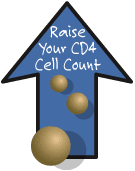Maraviroc
(Selzentry) Produces Superior CD4 Cell Recovery after
48 Weeks
By
Liz Highleyman

In
the present analysis, David Asmuth from the University
of California at Davis and colleagues aimed to determine
factors associated with immunological response to
maraviroc-containing regimens in treatment-experienced
patients enrolled in the MOTIVATE 1 and 2 trials.
As
previously reported, these identical Phase 3 trials
(MOTIVATE 1 in the U.S. and Canada; MOTIVATE 2 in
the U.S., Europe, and Australia) together included
more than 1000 heavily treatment-experienced patients
with documented CCR5-tropic HIV and triple-class antiretroviral
drug resistance. Participants were randomly assigned
to receive maraviroc at doses of 150 mg once-daily
or 150 twice-daily, or else placebo, in combination
with optimized background therapy.
Most
study participants (90%) were men and the average
age was about 45 years. Patients had relatively advanced
disease, with a median CD4 cell count of 150-180 cells/mm3
and a mean HIV viral load of about 65,000 copies/mL.
This retrospective analysis included 1047 patients
in the 2 trials. The investigators evaluated longitudinal
changes in CD4 count, predictors of CD4 cell gains
at 48 weeks, and time to AIDS-defining (category C)
events.
Results
 |
At
48 weeks, median CD4 cell increases were significantly
larger in the one-daily and twice-daily maraviroc
arms compared with the placebo arm (92, 103,
and 24 cells/mm3, respectively; P < 0.05). |
 |
CD4
cell gains remained significantly larger with
maraviroc when considering only patients in
all treatment arms who achieved HIV RNA >
50 copies/mL (126, 125, and 96 cells/mm3, respectively;
P < 0.05). |
 |
CD4
cell increases in the maraviroc arm remained
significantly larger after adjusting for other
predictors of CD4 recovery including changes
in HIV viral load. |
 |
Patients
in the maraviroc arms took longer on average
to progress to category C events. |
 |
In
a multivariate analysis, having a higher on-treatment
CD4 count -- but not maraviroc use per se --
was protective against new AIDS-defining events
(hazard ratio 0.8, or 20% reduction, per additional
25 cells/mm3). |
Based
on these findings, the investigators concluded,
"MOTIVATE patients receiving maraviroc had
larger CD4 T-cell increases than those receiving
placebo, even after adjusting for the greater virologic
potency of maraviroc-containing regimens. This additional
CD4 response was associated with a longer time to
the development of AIDS-defining events on maraviroc."
University of California Davis, Sacramento, CA;
Pfizer Research and Development, New London, CT;
University of New South Wales, Sydney, Australia;
University of California San Diego, San Diego, CA;
Pfizer, Inc., New York, NY; Hospital Geneva University
Hospital, Geneva, Switzerland.
1/05/10
Reference
DM Asmuth, J Goodrich, DA Cooper, and others.
CD4+ T-Cell Restoration After 48 Weeks in the Maraviroc
Treatment-Experienced Trials MOTIVATE 1 and 2. Journal
of Acquired Immune Deficiency Syndromes (Abstract).
December 9, 2009 (Epub ahead of print).

|
|
|